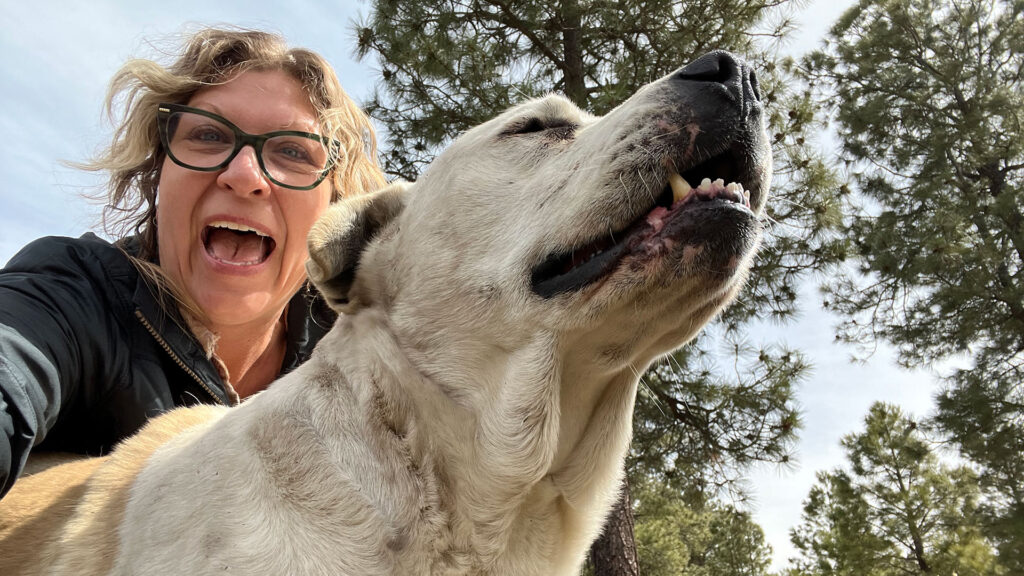Reclamation: Expect low run-off on the Rio Grande

Last week, the Our Land crew was in northern New Mexico filming for a series we’ll be airing later this year, “Loving Our Changing Homelands.” I’m looking forward to sharing more about this project in the coming months, which is funded by a climate engagement grant from PBS. But just a head’s up, if you ever let us visit you and your family’s land, I’ll spend a lot of my time with your dog. Consider yourself warned.
In the meantime, just a reminder that New Mexico teachers have until April 10 to apply for the Our Land Teaching Fellowship, which kicks off with a teacher training event in Albuquerque on June 22. For more information, head to the NMPBS website.
In 1998, the U.S. Fish and Wildlife Service and its partners introduced seven captive-bred Mexican wolves into the Gila National Forest.
Last week, the U.S. Fish and Wildlife Service announced there are now at least 257 Mexican wolves in the wild; that includes 37 packs in New Mexico and 23 in Arizona. They also documented that 138 pups were born last year and 86 survived in the wild. That’s just a slight bump from last year, which has activists continuing to call for changes in the program.
And while most New Mexicans have opinions about wolf reintroduction, most people will never see a wild wolf.
At the end of January, NMPBS videographer John Britt and I joined biologists, who use different tools for the count, including remote cameras and scat collection. Here, you’ll see helicopter crews bringing in two female wolves—one from the Leon Pack and another from the Cottonwood Canyon Pack—they’d tracked by telemetry and then darted to be treated by veterinarians and fitted with GPS collars.
On New Mexico in Focus last week, Source New Mexico reporter Patrick Lohmann hosted a roundtable conversation with Hermits Peak Calf Canyon Fire survivors Kayt Peck and Yolanda Cruz, who have advice for other communities. You can watch that online if you missed it last Friday.
Last week, the U.S. Bureau of Reclamation announced that water managers are “expecting a low spring runoff this year on the Rio Grande.” They noted that the Natural Resources Conservation Service’s (NRCS) latest forecast for runoff into El Vado Reservoir predicts inflow at only 46 percent of median.
They cautioned that “conditions can change dramatically and it is still too early to make reliable predictions.” But it’s important to recall that last year’s abysmal conditions on the Rio Grande came after inflow to El Vado was 177 percent of median.
According to Reclamation, Elephant Butte Reservoir is now 25 percent full compared to about 14 percent this time last year, and irrigation deliveries are starting earlier: “Elephant Butte Dam releases began on Feb. 15, while Caballo Dam releases will begin March 8 for farmers in southern New Mexico, west Texas, and Mexico.”
They also anticipate the Rio Grande could dry in the San Acacia and Isleta reaches, as it often does each summer, as well as within Albuquerque.
To look at the NRCS’s streamflow data for the Rio Grande, visit their Interactive Map and Forecast Charts, where you should check out the localized data, as conditions vary across the watershed. (You can check out the same for the Colorado River, too: Interactive Map and Forecast Charts.)
On the portal for the Middle Rio Grande Endangered Species Collaborative, they’ve posted relevant literature published in 2023. For those interested in the Middle Rio Grande, endangered species, and climate change, it’s a great link to bookmark.
Speaking of the Rio Grande, water attorney Samantha Barncastle Salopek just announced she is running for New Mexico State Senate (District 38). And speaking of politics, a few weeks ago Albuquerque physician Anjali Taneja announced her bid for the New Mexico House of Representatives (District 18).
Now, for a look at some of the news:
• “‘We can do better’: Western states divided over long-term plans for Colorado River water” (Ian James, Los Angeles Times)
• “States are far apart on new Colorado River water-saving plans sent to U.S. agency” (Tony Davis, Arizona Daily Star)
• “Much of America asks: Where did winter go? Spring starts early as US winter was warmest on record” (Seth Borenstein, Associated Press)
• “River runs past, but water isn’t for New Mexico” (Danielle Prokop, Source New Mexico)
• “Oil and Gas Companies Want You to Think They Care About Women — but It’s Just PR” (Ellen Ormesher, Emily Gertz, Kathryn Clare, and Cartie Werthman, DeSmog)
• “The Obscene Energy Demands of A.I.” (Elizabeth Kolbert, The New Yorker)
I finished reading Linda Hogan’s 1998 novel Power a couple of weeks ago. But I haven’t stopped thinking about it. If you’ve never read it, perhaps now is the time.
P.S. If a friend forwarded you this message, sign up here to receive the newsletter yourself. You can also read recent newsletters online. And if you miss us throughout the week, follow Our Land on Instagram.


